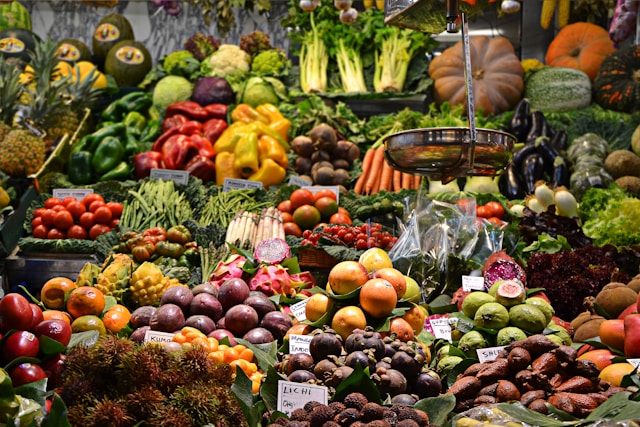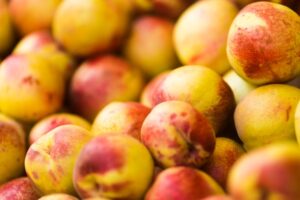Let’s get right to it. Sodium in fruit—is there sodium in fruit? Yes, but only a tiny amount. Fruits might seem sodium-free, but they naturally contain trace amounts. The key is knowing exactly how much and which types to watch. Whether you’re managing your own diet or guiding others, this is one detail worth understanding.
Is There Sodium in Fruit?
Yes, there is. But in fresh fruits, the amounts are so small they’re almost insignificant. We’re talking 1 to 3 milligrams per serving in most cases. An apple? About 1 mg. A cup of watermelon? Around 1.5 mg. Compare that to the daily recommended sodium limit of 2,300 mg for most adults, and you see just how minimal it is.
Still, those milligrams matter when you’re building a nutrition plan for someone on a strict low-sodium diet. It’s about precision—and fresh fruit makes it easy to stay within healthy limits.
How Much Sodium Is in Fruit — and What Counts as Low or High?
Let’s get specific. Most fresh fruits are considered very low in sodium. The general definition of a “low sodium” food is less than 140 mg per serving—meaning almost every fresh fruit qualifies by a huge margin.
But here’s the twist: sodium in fruit can change dramatically depending on how it’s prepared or stored. While fresh produce is naturally low, certain preserved or processed fruits can pack a surprisingly salty punch.
For example:
- Green olives (pickled) can have over 200 mg of sodium in just a few pieces.
- Dried mango with added sugar and preservatives can reach over 150 mg per 100 g.
That’s a massive difference from the 1–3 mg found in fresh fruit.
Sodium in Fruit Chart: Fresh vs. Processed
Here’s a simple breakdown showing how sodium levels shift between fresh and processed fruit:
| Fruit Type | Typical Sodium |
|---|---|
| Fresh apple, berries, watermelon, mango | 1–3 mg per serving |
| Dried or sweetened fruits (mango, peaches) | 100–160 mg per 100 g |
| Pickled fruits (olives) | ~230 mg for a small portion |
As you can see, fruit low in sodium is the norm, but fruit high in sodium usually comes from processing or preservation.
Does Fruit Have Sodium in Them? The Full Picture
Yes—every fruit has some sodium. But the important thing to remember is how minimal it is in its natural state.
Fresh Fruit: Naturally Low in Sodium
Most fresh fruits—think apples, berries, oranges, and melons—are naturally low in sodium. They’re excellent for anyone aiming to reduce salt intake without sacrificing flavor or nutrition.
Processed or Preserved: Where Sodium Spikes
Once fruit is dried, canned, pickled, or otherwise processed, sodium can increase significantly. That’s why label-reading is critical if you’re buying packaged fruit snacks or preserved products.
Why This Matters
For individuals with hypertension, kidney concerns, or any condition requiring sodium restriction, this small detail can have a big impact on health outcomes.
Fruits High in Sodium vs. Fruits Low in Sodium
If you’re making recommendations or planning meals, here’s the easy separation:
- Fruits Low in Sodium: Fresh apples, berries, citrus fruits, grapes, watermelon, bananas, peaches, mangoes. All under 3 mg per serving.
- Fruits High in Sodium: Pickled olives, salted dried fruits, certain canned fruits in brine or syrup. These can range from 100–300 mg per serving.
The difference is huge—and it comes down to how the fruit is handled before it reaches your plate.
How Much Sodium Is in Fruit? Practical Guidelines
On average, here’s what you can expect:
- Fresh fruit: 0–3 mg sodium per serving.
- Frozen fruit (no added ingredients): Similar to fresh, around 0–3 mg.
- Dried fruit (unsweetened): Usually under 10 mg, but check the label.
- Processed/preserved fruit: Anywhere from 50 mg to over 200 mg, depending on the product.
These numbers make one thing clear: fresh is almost always the best choice for keeping sodium low.
Actionable Tips for Managing Sodium in Fruit
- Choose Fresh Whenever Possible
Fresh fruit not only keeps sodium intake minimal but also retains the most nutrients. - Check Labels on Packaged Fruit
Even dried or frozen fruit can contain added sodium. Look for “no added salt” or “unsalted” options. - Be Cautious with Preserved Fruits
Pickled or brined fruits can spike sodium intake quickly. - Use Fresh Herbs Instead of Salty Fruit Add-Ins
For recipes that call for olives or other high-sodium fruits, try swapping with fresh herbs or citrus zest for flavor. - Balance Sodium with Potassium
Potassium-rich fruits like bananas and oranges help balance sodium levels in the body.
Why Low Sodium in Fruit Matters
Low sodium isn’t just a buzzword—it has real health implications. Excess sodium can increase blood pressure, strain the kidneys, and contribute to fluid retention. By choosing fruit low in sodium, you’re helping support cardiovascular health, kidney function, and overall wellness.
For athletes and active individuals, naturally low-sodium fruits can be a smart choice during normal meals—reserving higher sodium intake for post-workout recovery when electrolyte replacement is needed.
The Big Takeaways
Here’s what you now know:
- Is there sodium in fruit? Yes, but it’s minimal in fresh varieties.
- How much sodium is in fruit? Typically 1–3 mg per serving in fresh fruit; much higher in processed.
- Fruit high in sodium usually means pickled, brined, or heavily processed products.
- Fruit low in sodium covers nearly all fresh fruits.
If you’re guiding clients, managing a health condition, or just making better food choices, remember: fresh fruit is almost always your low-sodium friend.
Sodium in Fruit
| FRUIT SELECTION | SERVING SIZE & PREPARATION | Sodium Per Milligrams |
| Cranberries | 1/2 cup | trace |
| Grapefruit | 1/2 | 0 |
| Blackberries,Fresh | 1 cup | 0 |
| Raspberries | 1 cup | 0 |
| Orange | 1 medium | 0 |
| Peach, Fresh | 1 medium | 0 |
| Plums | 2 medium | 0 |
| Nectarine | 1 medium | 0 |
| Dates | 5 medium | 1 |
| Apple, Fresh | 1 medium with skin | 1 |
| Cherries, Fresh | 1/3 ounce (about 3) | 1 |
| Banana, Fresh | 1 medium | 1 |
| Apricots ,Fresh | 3 medium | 1 |
| Chayote | 1/2 cup | 1 |
| Strawberries | 1 cup | 1 |
| Tangerines | 1 medium | 1 |
| Lemons | 1/2 medium | 1 |
| Lime | 1/2 medium | 1 |
| Pear, Fresh | 1 medium | 1 |
| Currants, Black | 1 cup | 2 |
| Figs | 3 medium | 2 |
| Breadfruit | 1/4 – about 3 ounces | 2 |
| Pineapple | 1 cup | 2 |
| Prunes | 5 medium | 2 |
| Mango | 1/2 medium | 2 |
| Persimmon | 1 medium | 2 |
| Pummelos | 1 cup | 2 |
| Pomegranate | 1/2 medium | 2 |
| Grapes | 1 cup | 2 |
| Casaba Melon | 1 cup | 3 |
| Guava | 1 medium | 3 |
| Watermelon | 1 cup | 3 |
| Apricots, Dried | 10 halves | 4 |
| Kiwi | 1 medium | 4 |
| Quince | 1 medium | 4 |
| Plantains | 1/2 cup | 4 |
| Peach, Dried | 5 halves | 5 |
| Prickly Pear | 1 medium | 5 |
| Pear, Dried | 5 halves | 5 |
| Papaya | 1/2 medium | 5 |
| Kumquats | 5 medium | 6 |
| Figs, Dried | 3 medium | 6 |
| Blueberries, Fresh | 1 cup | 9 |
| Raisins, Dark Seedless | 1/2 cup | 9 |
| Raisins, Golden Seedless | 1/2 cup | 9 |
| Avocado | 1/2 medium | 10 |
| Cantaloupe | 1 cup | 14 |
| Honeydew Melon | 1 cup | 17 |
| Passion Fruit | 5 medium | 28 |
| Apples, Dried | 10 rings | 56 |
| DESSERTS | SERVING SIZE & PREPARATION | SODIUM |
| Vanilla Ice Cream | 1/2 cup | 50 |
| Apple Pie | 1 slice | 400 |
| Banana Cream Pie | 1 slice | 275 |
| Chocolate Cream Pie | 1 slice | 275 |
| Lemon Chiffon Pie | 1 slice | 200 |
| Pecan Pie | 1 slice | 950 |
| Pumpkin Pie | 1 slice | 250 |
| Corn Pudding | 1/2 cup | 75 |
| Rice Pudding | 1/2 cup | 95 |
FAQs About Sodium in Fruit
Yes, all fruit contains some sodium, but in fresh fruit, the amount is extremely low—usually 1–3 mg per serving.
High-sodium fruits are usually processed or preserved, such as pickled olives or salted dried fruits, which can have over 200 mg per serving.
Most fresh fruits—like apples, berries, oranges, grapes, and watermelon—are naturally low in sodium, with less than 3 mg per serving.
Fresh fruit generally contains 0–3 mg of sodium per serving, while processed fruits can range from 50–300 mg depending on preparation.
Yes, sodium occurs naturally in fruit, but in very small amounts that are generally not a concern for most healthy diets.
If you’re on a sodium-restricted diet, monitoring even small amounts helps you stay within daily limits, especially if you also eat processed fruit.
Choose fresh, whole fruit and avoid preserved, pickled, or salted varieties. Always check nutrition labels for added sodium.


